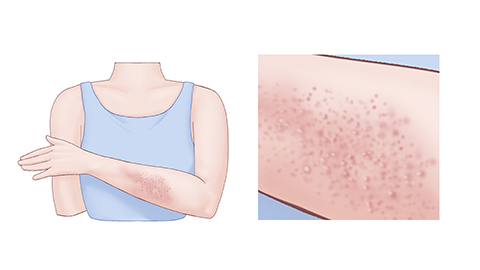Why are there small red spots on the arms?
Generally, the sudden appearance of small red spots on the arms may be caused by skin friction irritation, insect bites, allergic dermatitis, eczema, thrombocytopenic purpura, or other reasons. If discomfort occurs, it is recommended to seek medical attention promptly and receive treatment under the guidance of a physician. Detailed explanations are as follows:

1. Skin Friction Irritation
When the skin on the arms experiences repeated friction, such as from rough clothing materials, tight accessories, or activities requiring frequent arm use, the outer layer of the skin (stratum corneum) can be damaged. This causes the skin to have a stress reaction, leading to localized capillary dilation and the appearance of small red spots. In daily life, choose soft, comfortable, and skin-friendly clothing, and avoid wearing tight accessories.
2. Insect Bites
When insects bite humans, they inject saliva into the skin. This saliva contains various proteins and anticoagulant substances that trigger an immune response from the human immune system. After recognizing these foreign substances, the immune system releases inflammatory mediators such as histamine, causing localized skin vasodilation and increased permeability, which results in small red spots. After an insect bite, it is recommended to apply insect repellent on exposed skin areas, use mosquito nets, maintain a clean and hygienic living environment, and reduce mosquito breeding.
3. Allergic Dermatitis
Allergic dermatitis is usually triggered by contact with allergens such as cosmetics, detergents, or plants. When the skin comes into contact with an allergen, the immune system identifies it as a harmful foreign substance, initiates an immune response, and produces antibodies, leading to an inflammatory reaction on the skin and the appearance of small red spots. Symptoms may also include itching, redness, swelling, and flaking. Patients can use medications such as calamine lotion, difluprednate cream, and loratadine tablets under the guidance of a physician.
4. Eczema
Eczema may be related to multiple factors such as heredity, immune abnormalities, environmental factors, and impaired skin barrier function. These factors together can cause immune dysregulation in the skin, triggering an inflammatory response. Inflammation causes intercellular edema in the epidermis, forming small red spots. In severe cases, blisters and exudation may occur. Intense itching, skin erosion, and crusting may also develop. Patients can use medications such as hydrocortisone butyrate cream, mometasone furoate cream, and compound glycyrrhizin tablets according to a physician's recommendations to alleviate symptoms.
5. Thrombocytopenic Purpura
Thrombocytopenic purpura may occur due to insufficient platelet production, excessive destruction, or increased consumption, resulting in reduced platelet count in the blood. Platelets play an important role in blood clotting, and a reduced number can impair clotting function, making the skin and mucous membranes prone to bleeding spots, which manifest as small red spots on the arms. Other symptoms may include nosebleeds, gum bleeding, and heavy menstrual bleeding. Patients should follow medical advice to use medications such as platelet-increasing capsules, aminopeptide tablets, and recombinant human thrombopoietin injections for treatment.
In daily life, wear loose clothing, eat more fresh vegetables and fruits, and ensure adequate protein intake to help prevent the occurrence of diseases.







